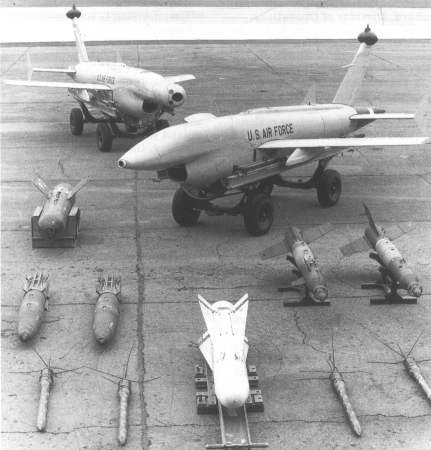So what's new? The Royal Navy was operating a radio-controlled pilotless drone back in the 1930s - the de Havilland Queen Bee, a derivative of the Tiger Moth - and the bloody AA gunners couldn't usually hit that either.

In the late 1960s, the Navy studied the possibility to convert the BQM-34A Firebee target drone to a remote-controlled anti-ship missile. In several test flights, BQM-34As equipped with a TV system in the nose, were successfully flown by remote "pilots" watching the TV image. Precision low-level flight above the sea was made possible by the Ryan-developed RALACS (Radar Altimeter Low Altitude Control System). In September 1971, successful tests of Model 248 missiles (called "BQM/SSM") against ship targets showed the validity of the basic concept, but the project was terminated due to lack of funding.
In the same year, the USAF showed interest in a development of the Firebee I to be used for enemy air-defense suppression, because of the high loss rate in these missions. In March 1971, Teledyne Ryan received a contract to convert four Model 147S drones to BGM-34A (Model 234) configuration. Like the Navy's BQM/SSM, the BGM-34A was piloted by an operator watching a TV image transmitted from the drone's nose.
In tests during 1971/72, the BGM-34As successfully launched AGM-65 Maverickair-to-surface missiles and electro-optically guided glide bombs against simulated SAM sites. Interestingly, almost 30 years later a firing of an AGM-114 Hellfire missile by an MQ-1L Predator UAV was much hyped as a breakthrough in armed UAV technology.
Following the successful BGM-34A tests, Teledyne Ryan developed the BGM-34B (Model 234A) operational strike RPV. This featured the higher-rated J69-T-41A engine, a modified tail, larger control surfaces, and improved operational capabilities. Eight BGM-34Bs were built, and tested in 1973/74. The tests included the modification of some of the drones with a new nose containing a LLLTV (Low Light Level Television) camera and a laser designator, to act as a "pathfinder" for weapon-carrying RPVs.

Whats old is the new new...